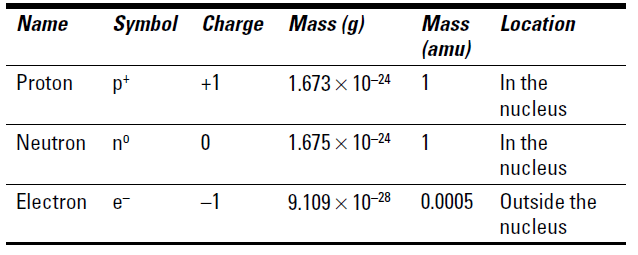
Subatomic Particles
 المؤلف:
John T. Moore, EdD
المؤلف:
John T. Moore, EdD
 المصدر:
Chemistry Essentials For Dummies
المصدر:
Chemistry Essentials For Dummies
 الجزء والصفحة:
p18
الجزء والصفحة:
p18
 17-2-2016
17-2-2016
 3086
3086
Subatomic Particles
The atom is the smallest part of matter that represents a particular element. For quite a while, the atom was thought to be the smallest part of matter that could exist. But in the latter part of the 19th century and early part of the 20th, scientists discovered that atoms are composed of certain subatomic particles and that no matter what the element, the same subatomic particles make up the atom. The number of the various subatomic particles is the only thing that varies.
Scientists now recognize that there are many subatomic particles (this really makes physicists salivate). But to be successful in chemistry, you really only need to be concerned with the three major subatomic particles:
✓ Protons
✓ Neutrons
✓ Electrons
Table 1 summarizes the characteristics of these three subatomic particles. The masses of the subatomic particles are listed in two ways: grams and amu, which stands for atomic mass units. Expressing mass in amu is much easier than using the gram equivalent.
Table 1 The Three Major Subatomic Particles

Atomic mass units are based on something called the carbon- 12 scale, a worldwide standard thatfs been adopted for atomic weights. By international agreement, a carbon atom that contains six protons and six neutrons has an atomic weight of exactly 12 amu, so 1 amu is defined as 1.12 of this carbon atom.
Because the masses in grams of protons and neutrons are almost exactly the same, both protons and neutrons are said to have a mass of 1 amu. Notice that the mass of an electron is much smaller than that of either a proton or neutron. It takes almost 2,000 electrons to equal the mass of a single proton.
Table 1 also shows the electrical charge associated with each subatomic particle. Matter can be electrically charged in one of two ways: positive or negative. The proton carries one unit of positive charge, the electron carries one unit of negative charge, and the neutron has no charge . itfs neutral. Scientists have discovered through observation that objects with like charges, whether positive or negative, repel each other, and objects with unlike charges attract each other.
The atom itself has no charge. It’s neutral. (Well, actually, certain atoms can gain or lose electrons and acquire a charge, as we explain in the later section “Ions: Varying electrons.” Atoms that gain a charge, either positive or negative, are called ions.)
So how can an atom be neutral if it contains positively charged protons and negatively charged electrons? The answer is that there are equal numbers of protons and electrons — equal numbers of positive and negative charges — so they cancel each other out. The last column in Table 1 lists the location of the three subatomic particles. Protons and neutrons are located in the nucleus, a dense central core in the middle of the atom, and the electrons are located outside the nucleus .
 الاكثر قراءة في مقالات متنوعة في علم الكيمياء
الاكثر قراءة في مقالات متنوعة في علم الكيمياء
 اخر الاخبار
اخر الاخبار
اخبار العتبة العباسية المقدسة


